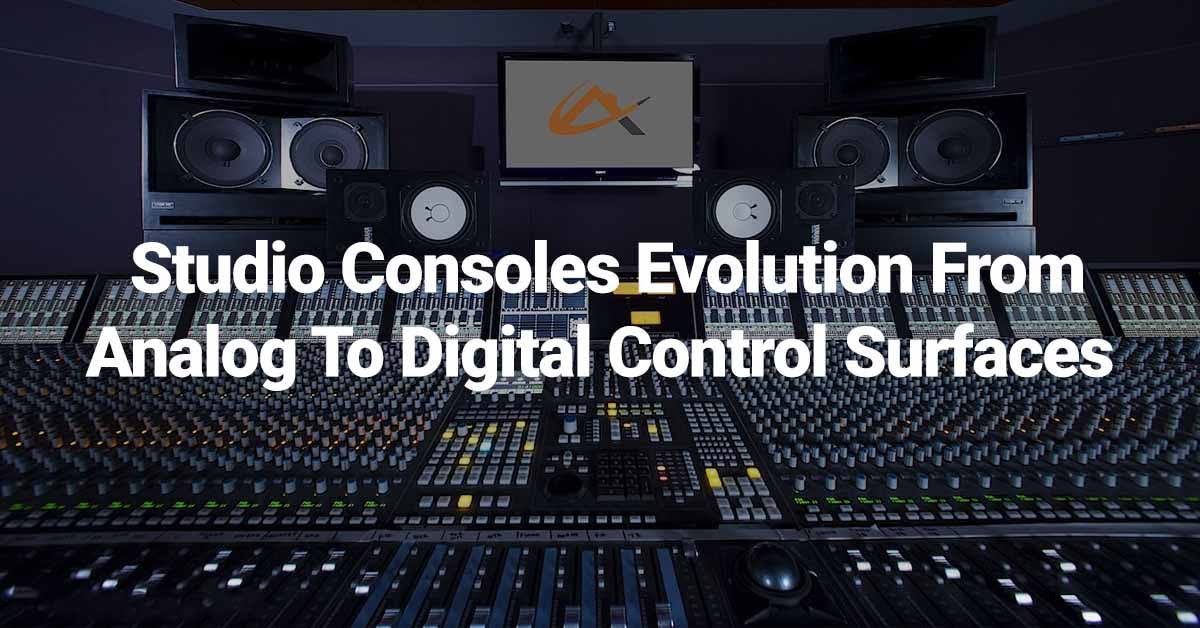Studio Consoles Evolution From Analog To Digital Control Surfaces

Mixing of consoles stands as the heart of every studio in sound engineering as it includes combining the signal flow, tone shaping, and creative expression. This defines how consoles are important for the sound to be sculpted and delivered be it producing the top pop track or any cinematic masterpiece. It is also important to understand that over decades these consoles have evolved so rapidly as per the changin the needs of the audio professionals. As the music production moved from being recorded from the tape machines to computers the consoles have transformed from towering analog desks to sleek digital interfaces. Hence, this blog explores the complete studio console evolution from analog to digital control surfaces which has transitioned in terms of produce, mix, and master sound.
The Golden Age Of Analog Consoles
The time from the 1960s through 1980s was the period of analog craftsmanship and many iconic brands crafted their legendary consoles. Also, the consoles crafted had become staple in many prestigious recording studios around the world. Moreover, there were many series crafted with robust construction, enriched tone, and distinct sound coloration. Hence, these consoles were not just the process of the sound that shaped the soul of the music. The iconic brands include Neve, Solid State Logic (SSL), and API and many studios like Abbey Road, Sunset Sound, and Ocean Way became synonymous with the analog sound that defined entire generations of music.
The Challenges Of Analog Workflows
The unique set of challenges in the analog workflows include
• The bulk size and cost — these desks were massive, often occupying entire rooms and requiring considerable investment and real estate.
• Complex signal routing — without any digital visualization, routing audio through an analog board was difficult and demanded deep technical knowledge and constant manual tweaking.
• Lack of automation and recall — every mix had to be manually documented or memorized, making revisions labor-intensive. Automation, where available, was mechanical and limited.
The limitations which started to find challenges in the traditional workflow especially with the studios as they needed faster turnaround times and versatile production environments.
The Digital Revolution In Consoles
The late 1990s and early 2000s saw a defining moment of change in audio production, bringing about the digital revolution that drastically altered the way studios functioned. The introduction of Digital Audio Workstations (DAWs) such as Pro Tools, Logic, and Cubase provided engineers with a new world of control, editing accuracy, and automation. These DAWs paved way for new recording and mixing music methods. Also, with the technology evolution they created a stage for the invention of digital control surface. Hence, this innovation bridged the gap between the analog mixing and the flexibility of digital workflows.
Pioneering manufacturers welcomed this shift with hybrid offerings. Consoles such as the SSL Delta and Duality maintained the warmth of analog circuitry with digital automation system integration. API’s 1608 console added automation modules, combining analog tone and session recall. Rupert Neve Designs’ SwiftMix added motorized fader control to traditional analog equipment, demonstrating the growing need for efficiency without compromising sound quality. These innovations brought with them a new age of blending, as engineers were able to merge hands-on analog precision with sleek, efficient digital tools.
Hybrid Consoles:
Hybrid consoles served as a potent tool for contemporary producers. These systems provided the warmth and depth of analog audio paths with the convenience of recall and DAW integration. The SSL AWS range featured high-end analog mic preamps and EQs with complete DAW control and automation. The Slate Raven system offered touchscreen platform that enabled hands-on access to plugins, mix windows, and editing operations.
Hybrid configurations became the norm in most professional and project studios, allowing engineers to tap into analog sonics while still enjoying the speed and flexibility demanded in contemporary production environments. Both producers and mix engineers across a variety of genres, from electronic music to orchestral scoring, were especially drawn to this synergy where both sonic character and session control are paramount.
Control Surfaces & Seamless DAW Integration
Contemporary control surfaces also transformed sound creation by operating as physical DAW extensions. These devices, with motorized fader banks, plugin controller knobs, transport buttons, and sometimes touchscreen display reduced the need for excessive mouse and keyboard operation. MIDI and USB connectivity made setup easy, converting any laptop-based recording environment into a tactile, intuitive studio setup.
Whether in movie post-production suites dealing with scores of tracks, live performance setups needing live access, or smaller bedroom studios looking for better ergonomics, control surfaces became essential. Devices such as the small PreSonus FaderPort or top-of-the-line Avid S6 provided solutions in every budget and requirement, allowing engineers to spend less time on technicalities and more time on creativity.
TASE, one of the best sound engineering colleges in Chennai, offers masterful knowledge by comprehending both the tools and the experience that stands behind them. Our students are offered with experiential insight into both analog and digital systems so they not only learn how to change the gear and why it sounds the way that it does. Because no matter how quickly technology seems to be moving, the essence of great engineering still lies in creativity, curiosity, and experience.

